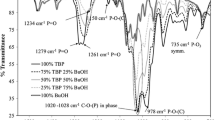Abstract
Ion-pair chromatography was tested for its applicability in determining monobutyl phosphate (MBP) and dibutyl phosphate (DBP), which are degradation products of tributyl phosphate, in Hanford tank wastes. In tests with simulant waste mixtures, tetrahexylammonium bromide, an ion-pairing agent, was used to complex with all three phosphate species. Recovery studies indicated that ion-pairing chromatography is quantitative for determining the analytes in spiked samples. Initial results demonstrated that DBP could be detected easily and was fairly well separated from other peaks, but MBP was frequently lost due to large negative peaks. Then a preconcentration column procedure was used to clean up the waste-sample matrix, and the negative peaks disappeared. Results indicated that 80% of MBP and 90% of DBP could be recovered. Most of the radioactivity was removed from actual waste tank samples so that additional sample preparation could be performed safely in a fume hood rather than a hot cell. Dibutyl phosphate was identified in an actual tank waste, but MBP was not found; this result was confimed by ion chromatography with conductivity detection.
Similar content being viewed by others
References
J. A. Campbell, R. M. Bean, Waste Tank Organic Safety Project: Analysis of Samples from Hanford Waste Tanks 241-C-102, 241-BY-108, and 241-C-103, PNL-10531, Pacific Northwest National Laboratory, Richland, Washington, 1995.
H. Babad, B. A. Crawford, R. D. Schreiber, J. A. Campbell, G. M. Mong, S. A. Bryan, R. D. Scheele, Chemically and Chemically-Related Considerations Associated with Sluicing Tank C-106 Waste to Tank AY-102. WHC-SD-WM-TI-756, Revision A, Draft, Westinghouse Hanford Company and Pacific Northwest National Laboratory, Richland, Washington, 1996.
Science and Technology of Tri-Butyl Phosphate, Vol. 1, byW. W. Schulz andJ. D. Navratil, (Eds), C. R. C. Press, Boca Raton, 1984.
M. V. Krishnamurthy, A. T. Sipahimalani, J. Radioanal. Nucl. Chem., 199 (1995) 197.
W. Davis, Jr., J. D. Navratil, A. Lászitty, Z. Horváth, Science and Technology of Tri-p-Butyl Phosphate, byW. W. Schulz andJ. D. Navratil (Eds), C. R. C. Press, Boca Raton, 1984, Chapter 8.
P. Bocek, V. Dolnik, M. Deml, J. Janak, J. Chromatogr., 195 (1980) 303.
M. P. Muller, J. Cojean, A. Deloge, Analysis, 13(4) (1985) 160.
W. Wilkinson, T. F. Williams, J. Chem. Soc. (1961) 4098.
M. V. Krishnamurthy, R. Sampathkumar, J. Radioanal. Nucl. Chem., 166 (1992) 421.
D. M. Camaioni, W. D. Samuels, B. D. Lenihan, S. A. Clauss, K. L. Wahl, J. A. Campbell, Organic Waste Tank Safety Program, Waste Aging Studies. PNL-10161, Pacific Northwest National Laboratory, Richland, Washington, 1994.
C. J. Hardy, D. Seargill, J. Inorg. Nucl. Chem., 10 (1959) 323.
Author information
Authors and Affiliations
Rights and permissions
About this article
Cite this article
Grant, K.E., Mong, G.M., Clauss, S.A. et al. Determination of monobutyl phosphate and dibutyl phosphate in mixed hazardous wastes by ion-pair chromatography. J Radioanal Nucl Chem 220, 31–35 (1997). https://doi.org/10.1007/BF02035343
Received:
Issue Date:
DOI: https://doi.org/10.1007/BF02035343




